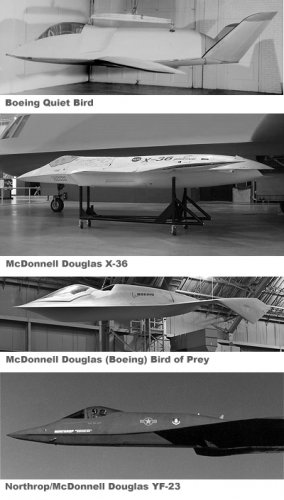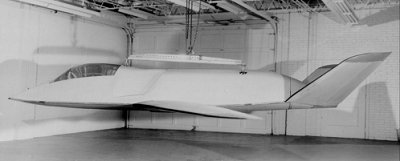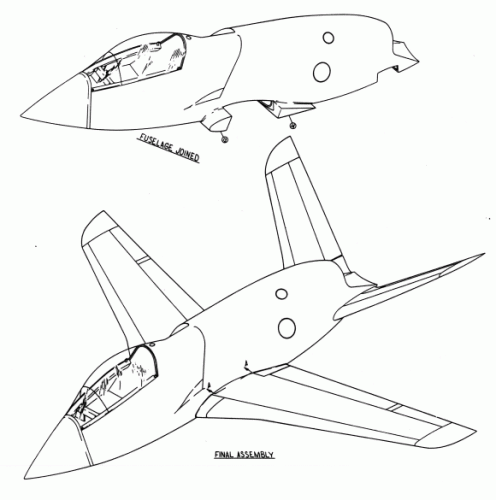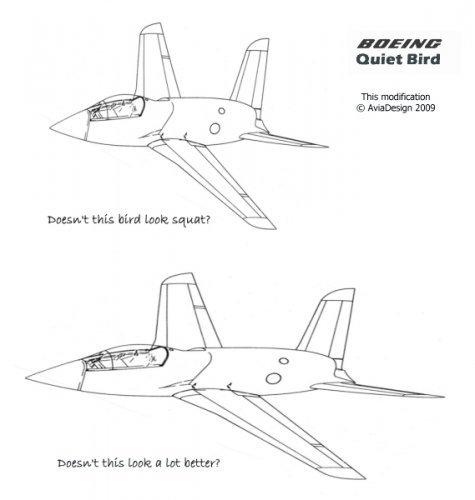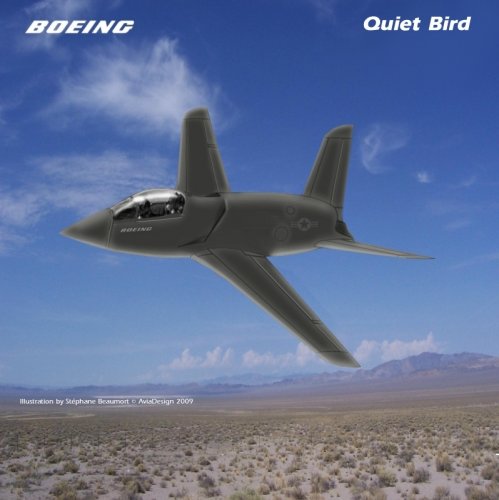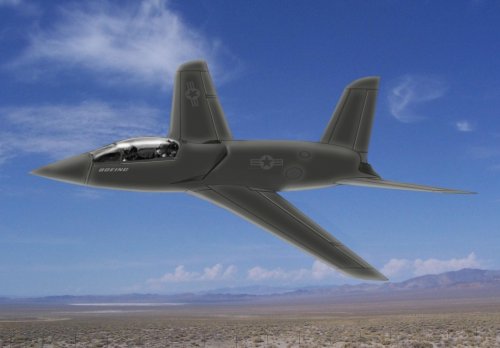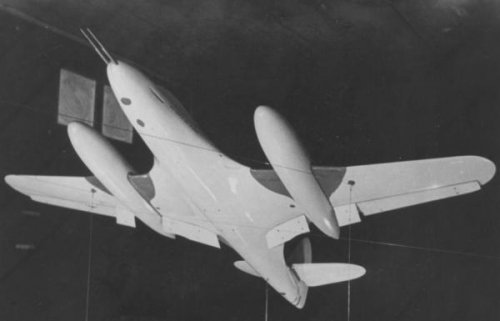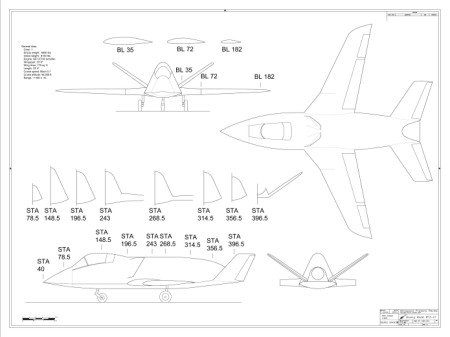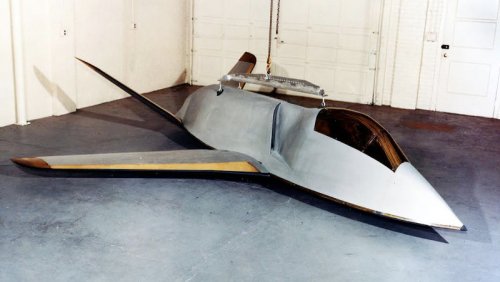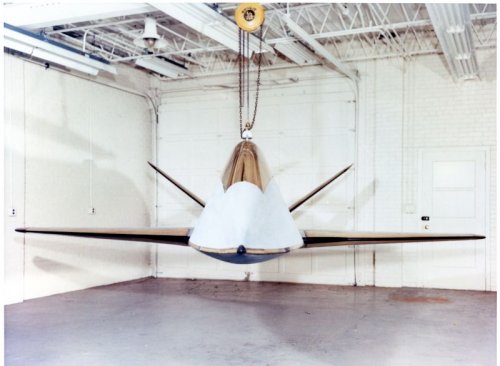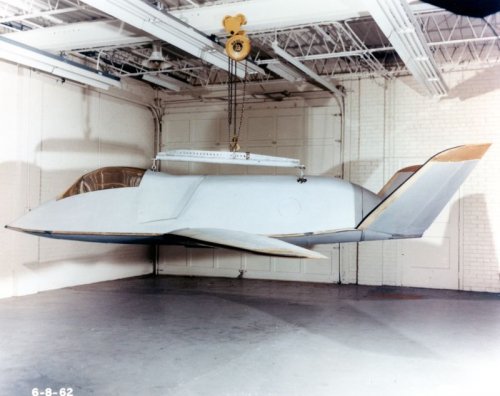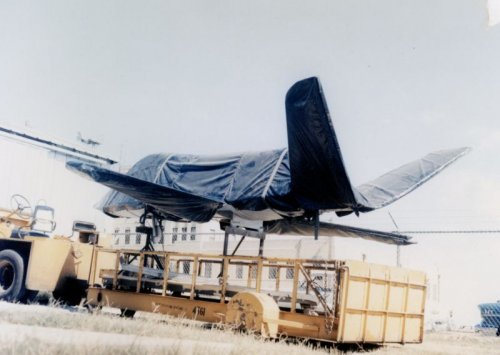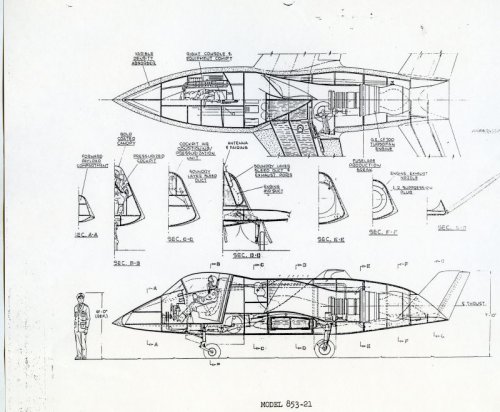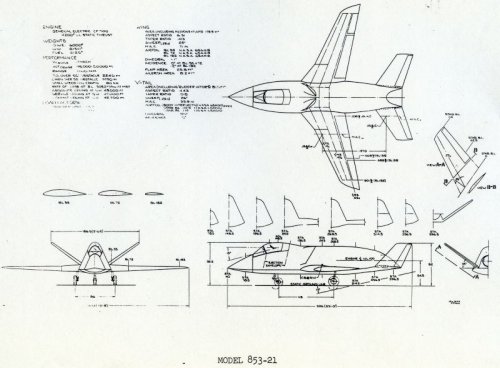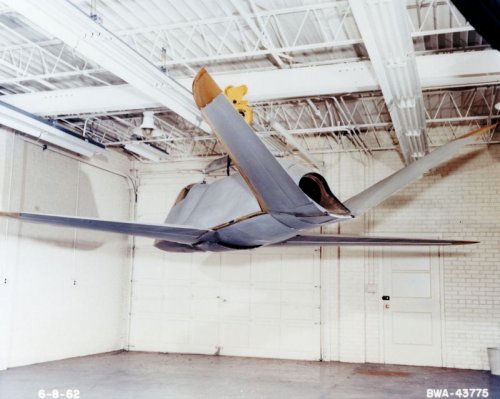You are using an out of date browser. It may not display this or other websites correctly.
You should upgrade or use an alternative browser.
You should upgrade or use an alternative browser.
Boeing "Quiet Bird" 1962 Stealth project
- Thread starter Orionblamblam
- Start date
Matej
Multiuniversal creator
Take a look at the patent, especially at the date...
- Joined
- 25 June 2009
- Messages
- 14,754
- Reaction score
- 6,155
Here is a little comparison between the Quiet Bird, the X-36, the Bird of Prey and the YF-23A.
I doubt that the Boeing connection can be found directly in the other three as the two companies merged less than two decades ago.
However, I believe that preliminary research on the Boeing article probably led to very precise specifications for all subsequent research aircraft based on what it helped to investigate. This could perhaps explain the relative similarity of certain features.
As an aside, I include a stretched version of the Quiet Bird (photo resized with no aspect ratio maintained). You'll see that it makes the design connection even more visible between the QB and the more recent projects.
I doubt that the Boeing connection can be found directly in the other three as the two companies merged less than two decades ago.
However, I believe that preliminary research on the Boeing article probably led to very precise specifications for all subsequent research aircraft based on what it helped to investigate. This could perhaps explain the relative similarity of certain features.
As an aside, I include a stretched version of the Quiet Bird (photo resized with no aspect ratio maintained). You'll see that it makes the design connection even more visible between the QB and the more recent projects.
Attachments
- Joined
- 18 March 2008
- Messages
- 3,529
- Reaction score
- 983
Stargazer2006 said:How can I possibly have missed that topic before??? ??? ??? ??
Same thing happened to me but with different threads... Looks like you've been promoted to Senior Member so can now see this new, restricted access part of the forum. Welcome aboard.
- Joined
- 25 June 2009
- Messages
- 14,754
- Reaction score
- 6,155
Abraham Gubler said:Stargazer2006 said:How can I possibly have missed that topic before??? ??? ??? ??
Same thing happened to me but with different threads... Looks like you've been promoted to Senior Member so can now see this new, restricted access part of the forum. Welcome aboard.
Don't know when that happened, but it's cool. Thanks!
- Joined
- 25 June 2009
- Messages
- 14,754
- Reaction score
- 6,155
This Quiet Bird has really inspired me... but don't you think it looks SQUAT???
Allow me to offer here:
1°) A comparison between the original diagram and an imaginary stretched version (obtained by resizing the image 150% x 100%)
2°) a color recreation of the aircraft in a desert setting, inspired by the original artwork in which I keep the proportions...
3°) another recreation in which I've used the imaginary stretched version whose proportions seem more realistic than the real article... (in both cases I readjusted the right wing according to perspective although it still doesn't look quite right).
This is NOT an official project at all and is not fit for this section... but since the graphics of the Quiet Bird are restricted to the "senior members" section for now, I don't want to spread it all around yet...
Allow me to offer here:
1°) A comparison between the original diagram and an imaginary stretched version (obtained by resizing the image 150% x 100%)
2°) a color recreation of the aircraft in a desert setting, inspired by the original artwork in which I keep the proportions...
3°) another recreation in which I've used the imaginary stretched version whose proportions seem more realistic than the real article... (in both cases I readjusted the right wing according to perspective although it still doesn't look quite right).
This is NOT an official project at all and is not fit for this section... but since the graphics of the Quiet Bird are restricted to the "senior members" section for now, I don't want to spread it all around yet...
Attachments
Matej
Multiuniversal creator
Not accurate but very nice from the aesthetic point of view. Just one detail - the colour scheme does not correspond to the correct era.
XP67_Moonbat
ACCESS: Top Secret
- Joined
- 16 January 2008
- Messages
- 2,271
- Reaction score
- 544
Not a bad design if do say say so myself! 
Moonbat
Moonbat
- Joined
- 27 December 2005
- Messages
- 17,751
- Reaction score
- 26,431
I think the Quiet Bird design happens to look the part, so we are impressed by it. I'm not sure it would actually have been that stealthy however. The shaping is rudimentary, it would have relied primarily on RAM.
- Joined
- 6 August 2007
- Messages
- 3,895
- Reaction score
- 5,983
overscan said:I think the Quiet Bird design happens to look the part, so we are impressed by it. I'm not sure it would actually have been that stealthy however. The shaping is rudimentary, it would have relied primarily on RAM.
They had a couple of things right, and overall I would say it was ahead of the it's peers at the time. Ryan made a lot of progress with RAM and inlet screens, this aircraft would have done a bit better I think.
- Joined
- 6 August 2007
- Messages
- 3,895
- Reaction score
- 5,983
quellish said:They had a couple of things right, and overall I would say it was ahead of the it's peers at the time. Ryan made a lot of progress with RAM and inlet screens, this aircraft would have done a bit better I think.
Apparently they got more right than I thought:
- Joined
- 27 December 2005
- Messages
- 17,751
- Reaction score
- 26,431
Interesting. What do the new patents add? At first glance, they seem exactly the same as the old ones.
- Joined
- 6 August 2007
- Messages
- 3,895
- Reaction score
- 5,983
overscan said:Interesting. What do the new patents add? At first glance, they seem exactly the same as the old ones.
I can't say I'm 100% sure yet. The dates on all of the QB patents are interesting. What additional novelty the individual patents cover that's not covered by the 2(?) broad ones that describe the whole system I don't yet know. What I've seen before is that there are additional details not shown unless you get the paper copy, though i do not know if that's the case here.
QB was clearly ahead of even the work we've seen dating from the 1970s, which continues to amaze me. They got a lot right, though not quite enough I think to get the dB reductions seen on the HAVE BLUE competitors. The methods outlined in the QB patents are in line with public knowledge of signature reduction previous to the F-117 becoming public, it would not surprise me if QB program veterans were sources for many of the articles full of Stealth Fighter conjecture.
XP67_Moonbat
ACCESS: Top Secret
- Joined
- 16 January 2008
- Messages
- 2,271
- Reaction score
- 544
Ghost Rocket has something about Quiet Bird.
- Joined
- 6 August 2007
- Messages
- 3,895
- Reaction score
- 5,983
Stargazer2006 said:Here is a little comparison between the Quiet Bird, the X-36, the Bird of Prey and the YF-23A.
I doubt that the Boeing connection can be found directly in the other three as the two companies merged less than two decades ago.
However, I believe that preliminary research on the Boeing article probably led to very precise specifications for all subsequent research aircraft based on what it helped to investigate. This could perhaps explain the relative similarity of certain features.
As an aside, I include a stretched version of the Quiet Bird (photo resized with no aspect ratio maintained). You'll see that it makes the design connection even more visible between the QB and the more recent projects.
When you are trying to reduce RCS on an aircraft, there is a tendency to converge on some of the same solutions. Large VLO platforms tend to look a lot like the early B-2, many current UCAVs have very similar outer mold lines, etc.
The Boeing (Quiet Bird) engineers did not have the modern analytical tools that the designers of the Bird of Prey and YF-23 had, but they were very determined and did have some tools that were far ahead of the times. The results of the Quiet Bird work, as far as I have been able to find out, were limited in distribution to Boeing and two other organizations - there most likely is not a direct connection between Quiet Bird and subsequent aircraft that are publicly known.
- Joined
- 27 December 2005
- Messages
- 17,751
- Reaction score
- 26,431
Main forum topic on Quiet Bird is here:
http://www.secretprojects.co.uk/forum/index.php/topic,7460
(senior members only)
Mr Lowther, is it OK to move to public section now?
http://www.secretprojects.co.uk/forum/index.php/topic,7460
(senior members only)
Mr Lowther, is it OK to move to public section now?
- Joined
- 6 August 2007
- Messages
- 3,895
- Reaction score
- 5,983
LONG ARM was a project evaluating medium jet aircraft (T-37) for Army battlefield observation needs. This would have been about the same time as the work on QUIET BIRD.
From:
http://www.dtic.mil/dtic/tr/fulltext/u2/a033626.pdf
"On 14 September, the Department of the Army approved the plan, subject to additional changes. CONARC then asked the Army Aviation School to submit personnel requisitions for the test unit, a detailed budget estimate, detailed plans for conduct of Phase II of the test, and a proposed TA for the test unit. The test unit for Project LONG ARM, as the T-37 test program was called, was activated by Third Army as the 7292d Aviation Unit on 5 November."
"The troop test of the T-37, as prepared by the Army Aviation School, had five objectives. First, to determine the most effective organization, the training, and logistical implications for higher performance Army observation aircraft within the field army, and to prepare tentative training literature. Second, to obtain an evalua- tion of higher performance observation aircraft vulnerability and survival probability when operating at various speeds and altitudes in the vicinity of enemy ground weapons, antiaircraft weapons, and surface-to-air guided missiles. This evaluation was to be based up- on the limitations of present and planned radar and weapons systems. and the reaction time of troops manning the weapons. Third, to determine the relative observation capabilities at various altitudes and speeds in both day and night operations. This objective would include determination of the capabilities for target identification. observer visibility transition training requirements, and observer adaptability from low to high speed aircraft and other factors affecting observation. Fourth, to develop and test operational procedures for target acquisition, damage assessment, surveillance, and adjustment of fire by higher performance Army observation air- craft. Finally, to recommend performance characteristics for a higher performance Army observation aircraft."
On 28 March 1958, the Department of the Army approved the extension of the T-37 test detachment thirough FY 1959 and extended the I in t the T-37 aircraft until January 1959. Long before the aircraft were returned to the Air Force, however, the Army had lost interest in Project LONG ARM. The Department of the Army was convinced that Air Force opposition had so influenced the thinking of the Joint Chiefs of Staff and the Department of Defense that it was not feasible to pursue the project. Additionally, the success in the development of the AO-1 MOHAWK airplane had met most of the observation requirements being studied in the tests."
From:
http://www.dtic.mil/dtic/tr/fulltext/u2/a033626.pdf
"On 14 September, the Department of the Army approved the plan, subject to additional changes. CONARC then asked the Army Aviation School to submit personnel requisitions for the test unit, a detailed budget estimate, detailed plans for conduct of Phase II of the test, and a proposed TA for the test unit. The test unit for Project LONG ARM, as the T-37 test program was called, was activated by Third Army as the 7292d Aviation Unit on 5 November."
"The troop test of the T-37, as prepared by the Army Aviation School, had five objectives. First, to determine the most effective organization, the training, and logistical implications for higher performance Army observation aircraft within the field army, and to prepare tentative training literature. Second, to obtain an evalua- tion of higher performance observation aircraft vulnerability and survival probability when operating at various speeds and altitudes in the vicinity of enemy ground weapons, antiaircraft weapons, and surface-to-air guided missiles. This evaluation was to be based up- on the limitations of present and planned radar and weapons systems. and the reaction time of troops manning the weapons. Third, to determine the relative observation capabilities at various altitudes and speeds in both day and night operations. This objective would include determination of the capabilities for target identification. observer visibility transition training requirements, and observer adaptability from low to high speed aircraft and other factors affecting observation. Fourth, to develop and test operational procedures for target acquisition, damage assessment, surveillance, and adjustment of fire by higher performance Army observation air- craft. Finally, to recommend performance characteristics for a higher performance Army observation aircraft."
On 28 March 1958, the Department of the Army approved the extension of the T-37 test detachment thirough FY 1959 and extended the I in t the T-37 aircraft until January 1959. Long before the aircraft were returned to the Air Force, however, the Army had lost interest in Project LONG ARM. The Department of the Army was convinced that Air Force opposition had so influenced the thinking of the Joint Chiefs of Staff and the Department of Defense that it was not feasible to pursue the project. Additionally, the success in the development of the AO-1 MOHAWK airplane had met most of the observation requirements being studied in the tests."
- Joined
- 27 December 2005
- Messages
- 17,751
- Reaction score
- 26,431
The Quiet Bird patent mentions a copending patent application 263,704 for "Open Cell Rigid Foam" by Marlan R. Pollock & Marlyn F. Harp.
This seems to have been abandoned (or not granted) and resubmitted in slightly modified form in 1982:
Open cell rigid thermoset foams and method
http://www.google.com/patents/US4454248
This seems to have been abandoned (or not granted) and resubmitted in slightly modified form in 1982:
Open cell rigid thermoset foams and method
http://www.google.com/patents/US4454248
XP67_Moonbat
ACCESS: Top Secret
- Joined
- 16 January 2008
- Messages
- 2,271
- Reaction score
- 544
More from Ghost Rocket on Quiet Bird.
A CAD diagram of the Quiet Bird is included in the December "rewards" for APR Patreon patrons:
http://www.aerospaceprojectsreview.com/blog/?p=2012
The high-end patrons get the 18X24 formatted PDF as well as the DXF vector format version.
http://www.aerospaceprojectsreview.com/blog/?p=2012
The high-end patrons get the 18X24 formatted PDF as well as the DXF vector format version.
Attachments
- Joined
- 31 December 2006
- Messages
- 803
- Reaction score
- 363
Foxtrot Alpha has new pictures of the Quiet Bird:
http://foxtrotalpha.jalopnik.com/never-seen-photos-of-boeings-1960s-stealth-jet-concept-1732308296
http://foxtrotalpha.jalopnik.com/never-seen-photos-of-boeings-1960s-stealth-jet-concept-1732308296
I
Ian33
Guest
There is a video where this exact aircraft is depicted following a Hercules airframe....except its a Lockheed wall the arts hanging on!
- Joined
- 25 June 2009
- Messages
- 14,754
- Reaction score
- 6,155
George Allegrezza said:Foxtrot Alpha has new pictures of the Quiet Bird:
http://foxtrotalpha.jalopnik.com/never-seen-photos-of-boeings-1960s-stealth-jet-concept-1732308296
SPECTACULAR!!! Thanks a bunch for sharing!
Steve Pace
Aviation History Writer
- Joined
- 6 January 2013
- Messages
- 2,266
- Reaction score
- 225
Marvelous - Thanks so much! -SPGeorge Allegrezza said:Foxtrot Alpha has new pictures of the Quiet Bird:
http://foxtrotalpha.jalopnik.com/never-seen-photos-of-boeings-1960s-stealth-jet-concept-1732308296
archipeppe
ACCESS: Top Secret
- Joined
- 18 October 2007
- Messages
- 2,431
- Reaction score
- 3,152
Coool!!!
- Joined
- 26 May 2006
- Messages
- 34,911
- Reaction score
- 15,789
George Allegrezza said:Foxtrot Alpha has new pictures of the Quiet Bird:
http://foxtrotalpha.jalopnik.com/never-seen-photos-of-boeings-1960s-stealth-jet-concept-1732308296
Great find George and we can put them here.
Attachments
XP67_Moonbat
ACCESS: Top Secret
- Joined
- 16 January 2008
- Messages
- 2,271
- Reaction score
- 544
Guess this isn't a private topic any more!
Dreamfighter
'Senior Something'
- Joined
- 13 July 2008
- Messages
- 483
- Reaction score
- 646
Great, thanks for sharing!
- Joined
- 27 December 2005
- Messages
- 17,751
- Reaction score
- 26,431
Merged with 6 year old topic from Private Discussions as pictures and info are now public.
- Joined
- 27 December 2005
- Messages
- 17,751
- Reaction score
- 26,431
It seems to me that this design got some of the basics of stealth absolutely right, and was impressive for its age, like the Lockheed A-12 but less constrained by required performance. It didn't have edge / planform alignment however. It would have been moderately hard to detect - but planform alignment was the key to significant reduction in RCS.
- Joined
- 6 November 2010
- Messages
- 5,263
- Reaction score
- 5,515
So. What else is lurking in 'Private Discussions'? Lord Lucan?PaulMM (Overscan) said:Merged with 6 year old topic from Private Discussions as pictures and info are now public.
- Joined
- 17 October 2006
- Messages
- 2,393
- Reaction score
- 1,197
Sssh!
Signed, Jack The Ripper
Signed, Jack The Ripper
Similar threads
-
-
-
Goodyear "Dynastat" giant transport projects
- Started by Stargazer
- Replies: 2
-
-
McDonnell Douglas & Boeing canard rotor wing (CRW) concepts
- Started by flateric
- Replies: 63

